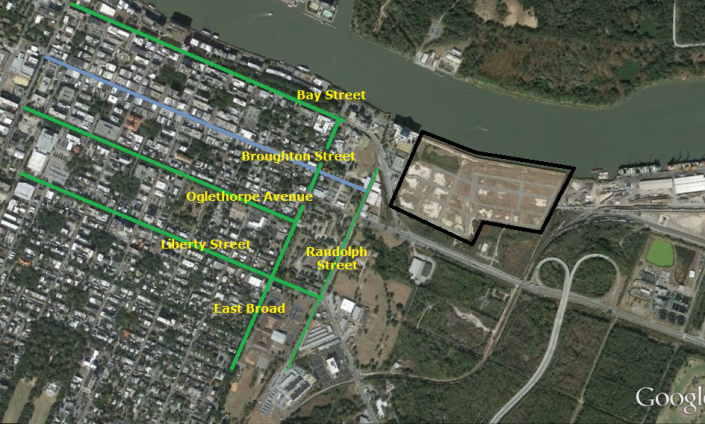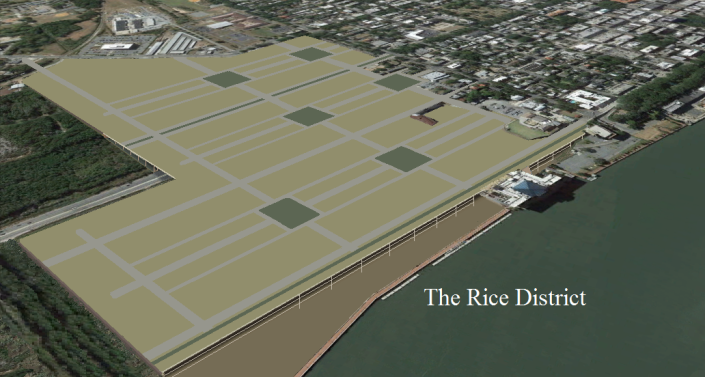“Where is the exhibition hall?” asked the visitor from Chicago.
“It’s just down Broughton Street,” came the answer from a local merchant, “At McAllister.”
“Really?” the visitor replied with a startled look, “I was just having dinner at that corner last night, and didn’t see anything the size of an exhibition hall.”
To which the merchant replied, “That’s because we know how to plan things well here. The exhibition hall was built below street level years ago when the Rice District was laid out.”
At one time the low lying land just east and south of Yamacraw Bluff, Savannah’s historic core, was viewed as a developmental problem. Lying immediately adjacent to an increasingly developed commercial and historic district, many a recent developer has eyed the land for its profit potential but as well has noted the high costs associated with developing such a flood prone site.
In colonial days, the large tract performed duty as a rice plantation until city leaders came to realize the stagnant waters were producing malarial ills, another high costs associated with its use. Since that time, some industrial uses have come and gone, but otherwise have left it largely an uninhabited space.
At the turn of the century, with the real estate market boom and the city’s hospitality industry still benefiting from John Berendt’s top selling book, Savannah’s commercial center drew more interest than usual from high flying developer types.
Unfortunately, the city’s political leadership eagerly jumped at the first offer of development to come along. They ventured so far as to pay for, via bond financing, basic utility infrastructure on a street plan provided by the developer, one that only vaguely resembled the original city plan and came with street widths 10, 15, and 20% narrower than those in other sections of the city center.
And yet the worst part of the Savannah River Landing (SRL) proposal/project was that it, like most most large scale property developments, insulated itself from any through traffic incursion. It has been this latter issue which has rendered for most U.S. cities gridlocked traffic nightmares.
Property developers have, since the days when local governments abdicated city planning duties, designed their right-of-ways for maximizing their property’s sales values, much to the detriment of the city as a whole.
Following that very bad habit of other U.S cities, the Savannah city government did not map out the new street system to connect in with the rest of the city. Like its counterparts elsewhere, Savannah abdicated this role to the developer.
Typically that right by the developer to do as they please, came with the responsibility to at the very least foot the bill on the infrastructure development. This is what makes Savannah’s instance particularly glaring. The city has footed the bill on the water and sewer infrastructure, but yet allowed the developer to insulate/segregate his property from the city’s traffic grid, placing a heavier burden on adjacent areas.
As the 2007 real estate crash snowballed through the economy, it took all of the wind out of the SRL project. Then came the public hand wrenching over the loss of anticipated property taxes from which to pay off the bonds on the infrastructure work already completed. But, there is a lustrous ‘silver lining’ in the forestalled project, in that now the city can take up a much better option for having this vacant area developed.
The better option not only corrects the above integration problem, but also provides a solution to an economic problem that has for the most part been shoved under the rug, in part out of denial, in part our of embarrassment, and in part out of having no creative and fiscally viable solutions.
This site raises the prospect of expanding the city’s hallmark urban plan onto this eastern section of the city, in both symmetry and connectivity. It notes the very feasible option of elevating street levels in the section to a level equal to that in the historic district. This option provides many benefits, especially the unique and much needed opportunity to place below street level convention related facilities, which are typically too large to fit unobtrusively into any urban street pattern, let alone Savannah’s.

